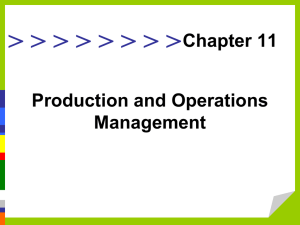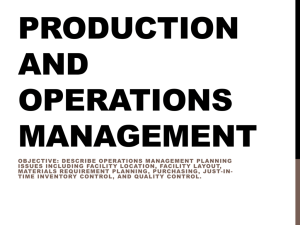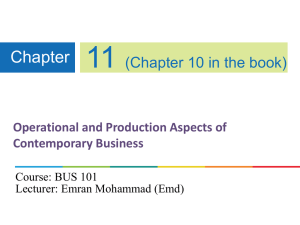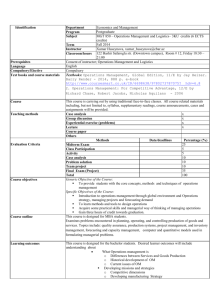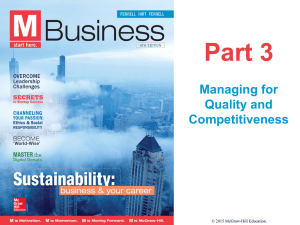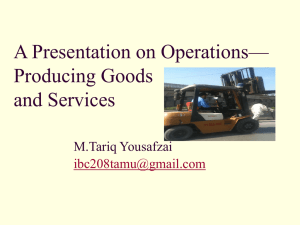Options for Organizing Small and Large Businesses
advertisement
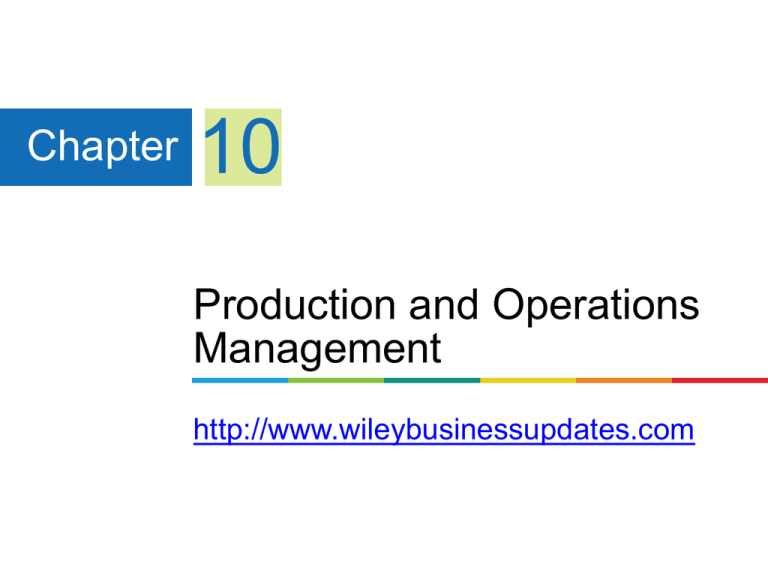
Chapter 10 Production and Operations Management http://www.wileybusinessupdates.com Learning Objectives 1 Explain the strategic importance of the production. 2 Identify and describe the production processes. 3 Explain the role of technology in the production process. 4 Identify the factors involved in a location decision. 5 Explain the job of production managers. 6 Discuss controlling the production process. 7 Determine the importance of quality. Production & Operations Management Production: Use of resources, such as workers and machinery, to convert materials into finished goods and services. Production and Operations Management: Oversee the production process by managing people and machinery in converting materials and resources into finished goods and services. Production Systems Strategic Importance of the Production Function A vital function is necessary for generating money to pay employees, lenders, and stockholders. Production is a vital function. Effective production and operations management can: lower a firm’s costs of production. boost the quality of its goods and services. allow it to respond dependably to customer demands. enable it to renew itself by providing new products. Mass, Flexible, and Customer-Driven Production Mass Production– a system for manufacturing products in large quantities through effective combinations of employees, with specialized skills, mechanization, and standardization Flexible Production– more cost-effective for producing smaller batches using information technology, communication, and cooperation Customer-Driven Production– evaluating customer demands in order to make the connection between products manufactured and products bought Production Processes Analytic production system reduces a raw material to its component parts in order to extract one or more marketable products. Synthetic production system Is the reverse of an analytic system. It combines a number of raw materials or parts or transforms raw materials to produce finished products. Continuous production process generates finished products over a lengthy period of time. An intermittent production process generates products in short production runs, shutting down machines frequently or changing their configurations to produce different products. Technology and the Production Process Robot- a reprogrammable machine capable of performing a variety of tasks that require the repeated manipulation of materials and tools. Computer-Aided Design– allows engineers to design components as well as entire products on computer screens faster and with fewer mistakes than they could achieve working with traditional drafting systems. Computer-Aided Manufacturing- computer tools to analyze CAD output and enable a manufacturer to analyze the steps that a machine must take to produce a needed product or part. Flexible Manufacturing Systems– a production facility that workers can quickly modify to manufacture different products. Computer-Integrated Manufacturing– production system in which computers help workers design products, control machines, handle materials, and control the production function in an integrated fashion. The Location Decision The Job of Production Managers Oversee the work of people and machinery to convert inputs (materials and resources) into finished goods and services. Planning the Production Process Choose what goods or services to offer customers. Convert original product ideas into final specifications. Design the most efficient facilities to produce those products. Planning the Production Process Selecting the Most Appropriate Layout Implementing the Production Plan Controlling the Production Process Process Layout Process layout groups machinery and equipment according to their functions. Facilitates production of a variety of nonstandard items in relatively small batches. Product Layout Product layout sets up production equipment along a product-flow line, and the work in process moves along this line past workstations. Efficiently produces large numbers of similar items. Fixed-Position Layout A fixed-position layout places the product in one spot, and workers, materials, and equipment come to it. Customer-Oriented Layout Customer-oriented layout arranges facilities to enhance the interactions between customers and a service. Implementing the Production Plan Make, Buy, or Lease Decision Choosing whether to manufacture a needed product or component in-house, purchase it from an outside supplier, or lease it. Factors in the decision include cost, availability of reliable outside suppliers, duration of the firm’s supply needs, and the need for confidentiality. Selection of Suppliers Based on comparison of quality, prices, dependability of delivery, and services offered by competing companies. Inventory Control Inventory Control function requiring production and operations managers to balance the need to keep stock on hand to meet demand against the costs of carrying inventory Perpetual inventory Vendor-managed inventory Just-in-Time Systems broad management philosophy that reaches beyond the narrow activity of inventory control to influence the entire system of production and operations management. Materials Requirement Planning computer-based production planning system that lets a firm ensure that it has all the parts and materials it needs to produce its output at the right time and place and in the right amounts. Controlling the Production Process Production control creates a well-defined set of procedures for coordinating people, materials, and machinery to provide maximum production efficiency. 1. Planning 2. Routing 3. Scheduling 4. Dispatching 5. Follow-up Gantt Chart PERT Diagram Importance of Quality A good or service free of deficiencies. Poor quality can account for 20% loss in revenue. Benchmarking is the process of analyzing other firms’ best practices. Quality control is measuring goods and services against established quality standards. Many companies evaluate quality using the Six Sigma concept. A company tries to make error-free products 99.9997% of the time, a tiny 3.4 errors per million opportunities. ISO Standards International Organization for Standardization (ISO)- mission is to promote the development of standardized products to facilitate trade and cooperation across national borders. Representatives from more than 146 nations. ISO 9000 series of standards sets requirements for quality processes. Nearly half a million ISO 9000 certificates have been awarded to companies around the world. ISO 14000 series also sets standards for operations that minimize harm to the environment.
